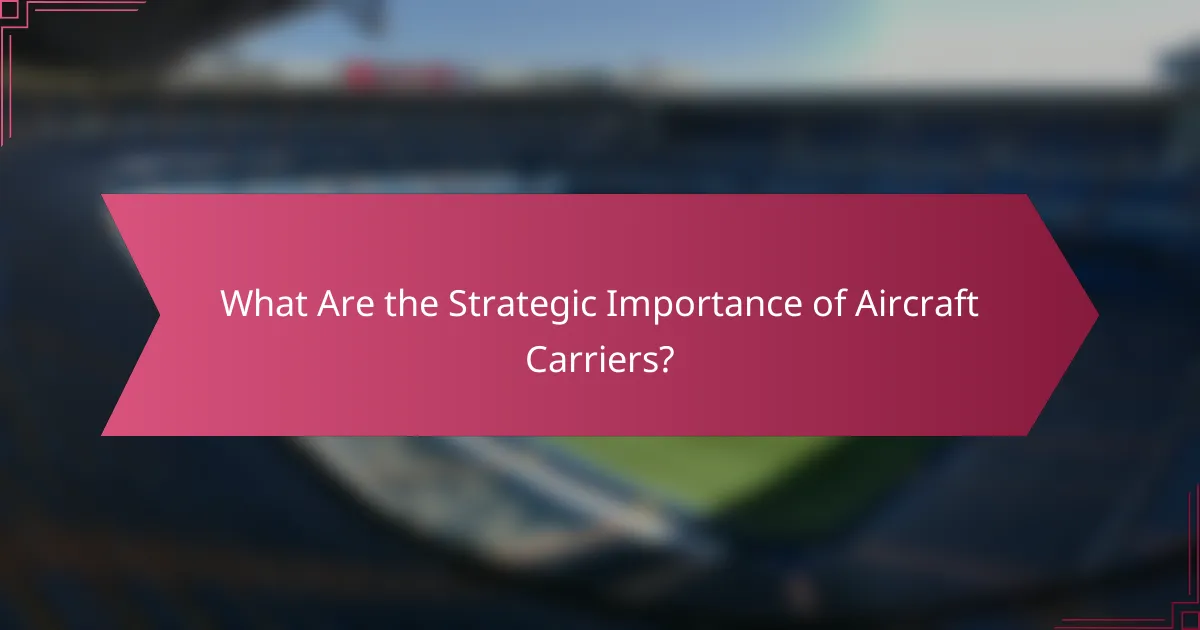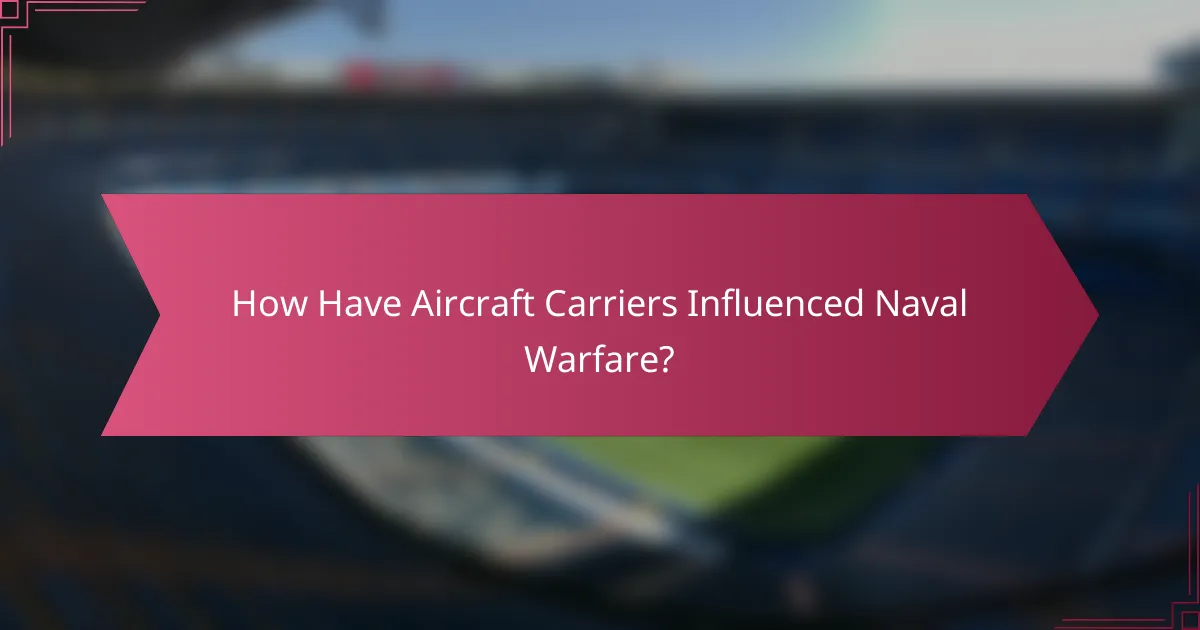Aircraft carriers are essential components of modern naval forces, acting as floating military bases that enhance a nation’s strategic and tactical capabilities. Their ability to project power and maintain a global presence allows for rapid deployment of air assets and effective responses to threats. Historically, these vessels have transformed naval warfare by enabling operations over vast distances, fundamentally altering the dynamics of maritime conflict.

What Are the Strategic Importance of Aircraft Carriers?
Aircraft carriers serve as floating military bases that enhance a nation’s strategic capabilities. Their ability to project power, deter adversaries, and maintain a global presence makes them vital assets in modern naval warfare.
Power projection
Power projection refers to the ability of a nation to deploy and sustain military forces in areas far from its own territory. Aircraft carriers enable this by allowing air strikes and support operations to be conducted from international waters, reducing the need for bases on foreign soil. For instance, a carrier strike group can launch air operations within a few hundred miles of a conflict zone, providing immediate military response capabilities.
Additionally, the presence of an aircraft carrier can influence regional stability by demonstrating military readiness and commitment. This can deter potential aggressors and reassure allies, making carriers a key component of a nation’s defense strategy.
Deterrence capabilities
Deterrence capabilities of aircraft carriers stem from their ability to project military power and serve as a visible reminder of a nation’s strength. The mere presence of a carrier group can dissuade hostile actions by adversaries, as they recognize the potential for swift and overwhelming military response. This psychological aspect of deterrence is crucial in maintaining peace and stability in volatile regions.
Moreover, aircraft carriers can be equipped with advanced weaponry and technology, enhancing their deterrent effect. For example, the deployment of stealth aircraft and precision-guided munitions aboard carriers can significantly increase their strike capabilities, making them formidable opponents in any conflict.
Global presence
The global presence of aircraft carriers allows nations to maintain influence and respond to crises worldwide. By operating in international waters, carriers can engage in humanitarian missions, disaster relief, and joint exercises with allied nations, reinforcing diplomatic ties and showcasing military capabilities.
Furthermore, the ability to reposition carriers quickly enhances a nation’s responsiveness to emerging threats. For example, during a regional conflict, a carrier can be deployed to provide air support or logistical assistance, demonstrating a commitment to international security and stability.

What Tactical Advantages Do Aircraft Carriers Provide?
Aircraft carriers offer significant tactical advantages by serving as mobile airbases that enhance naval power projection. They enable rapid deployment of air assets, provide a platform for various military operations, and enhance a nation’s ability to respond to threats effectively.
Versatility in operations
Aircraft carriers can conduct a wide range of operations, including air strikes, reconnaissance, and humanitarian missions. Their ability to launch and recover aircraft allows them to adapt to different combat scenarios and support various military objectives.
For example, a carrier can shift from offensive operations against enemy targets to providing disaster relief in a matter of hours. This flexibility makes them invaluable in both peacetime and wartime situations.
Air superiority
One of the primary roles of aircraft carriers is to establish and maintain air superiority over a battlefield. By deploying fighter jets and other aircraft, carriers can control the skies, which is crucial for the success of ground and naval operations.
Carriers typically operate a mix of aircraft, including interceptors and bombers, which can engage enemy aircraft and provide close air support to ground forces. This capability significantly increases the effectiveness of military operations and deters potential adversaries.
Logistical support
Aircraft carriers play a critical role in logistical support by providing a floating base for aircraft, which reduces the need for land-based facilities. This capability allows for sustained operations far from home ports, extending the reach of naval forces.
Additionally, carriers can support other naval vessels by providing fuel, munitions, and maintenance services. This logistical advantage enables a more efficient and coordinated military response in various operational theaters.

How Have Aircraft Carriers Influenced Naval Warfare?
Aircraft carriers have fundamentally transformed naval warfare by enabling power projection and providing air support far from home shores. Their ability to launch and recover aircraft allows navies to conduct operations over vast distances, changing the dynamics of maritime conflict.
Shift in naval tactics
The introduction of aircraft carriers led to a significant shift in naval tactics, moving from traditional ship-to-ship engagements to a focus on air superiority and strike capabilities. Naval commanders began to prioritize the use of carrier-based aircraft for reconnaissance, bombing, and anti-ship operations, which allowed for greater flexibility in engagements.
For example, during World War II, the Battle of Midway showcased how carriers could launch surprise attacks, altering the course of naval battles. Modern tactics now often involve carrier strike groups that combine air, surface, and subsurface assets to create a multi-dimensional threat.
Impact on fleet composition
The presence of aircraft carriers has significantly influenced fleet composition, necessitating a balance between carrier strike groups and supporting vessels. Modern navies typically include destroyers, submarines, and supply ships to protect and sustain carrier operations, creating a more complex and versatile fleet structure.
Naval forces now often prioritize the integration of advanced technologies, such as missile systems and electronic warfare capabilities, to enhance the effectiveness of carriers. This shift has led to an increased investment in specialized vessels designed to operate alongside carriers, ensuring they remain central to naval strategy.

What Are the Key Historical Events Involving Aircraft Carriers?
Aircraft carriers have played pivotal roles in numerous historical events, shaping naval warfare and international relations. Key events include the Battle of Midway during World War II and Operation Desert Storm in the early 1990s, both demonstrating the strategic importance and tactical advantages of aircraft carriers.
Battle of Midway
The Battle of Midway, fought in June 1942, marked a turning point in the Pacific Theater of World War II. U.S. aircraft carriers, particularly the USS Enterprise, USS Hornet, and USS Yorktown, successfully ambushed the Japanese fleet, which aimed to eliminate American naval power in the Pacific.
This battle showcased the effectiveness of carrier-based aircraft in naval engagements, leading to significant losses for Japan, including four aircraft carriers. The victory shifted the balance of power in the Pacific, highlighting the strategic importance of aircraft carriers in modern warfare.
Operation Desert Storm
Operation Desert Storm, launched in January 1991, was a key military campaign during the Gulf War, where aircraft carriers played a crucial role in the coalition’s success. The U.S. Navy deployed several carriers, including the USS Theodore Roosevelt and USS America, to launch airstrikes against Iraqi forces.
The use of carrier-based aircraft allowed for rapid and flexible response to targets, demonstrating the tactical advantages of carriers in modern conflict. This operation reinforced the concept of power projection, showcasing how aircraft carriers can serve as mobile airbases capable of influencing outcomes far from home shores.

How Do Aircraft Carriers Compare Globally?
Aircraft carriers are vital assets in naval power, serving as floating bases for air operations and projecting military strength. Their capabilities and strategic importance vary significantly among global naval forces, particularly between the United States, China, and the United Kingdom.
US Navy vs. Chinese Navy
The US Navy operates a fleet of nuclear-powered aircraft carriers, which are central to its blue-water strategy. These carriers can deploy a wide range of aircraft, enabling them to conduct air operations far from home shores, with a typical operational range of several thousand nautical miles.
In contrast, the Chinese Navy has been rapidly expanding its carrier capabilities, focusing on conventionally powered carriers that support its regional ambitions. While the US maintains a technological edge, China’s growing fleet reflects its increasing emphasis on naval power and regional influence.
UK’s Queen Elizabeth Class
The UK’s Queen Elizabeth Class aircraft carriers represent a significant modernization of British naval capabilities. These carriers are designed to operate with a mix of F-35B stealth fighters and various support aircraft, enhancing the UK’s ability to project power globally.
With a displacement of around 65,000 tons, these carriers are among the largest in the world and can support a variety of missions, from humanitarian assistance to full-scale military operations. Their versatility and advanced technology position the UK as a key player in international maritime security.

What Are the Future Trends in Aircraft Carrier Development?
The future of aircraft carrier development is shaped by technological advancements, emerging threats, and shifts in military strategy. These factors are driving innovations that enhance the capabilities and operational effectiveness of carriers in modern warfare.
Technological advancements
Technological advancements are crucial in the evolution of aircraft carriers, focusing on improved propulsion systems, stealth capabilities, and automation. For instance, the integration of electromagnetic aircraft launch systems (EMALS) allows for more efficient launching of aircraft compared to traditional steam catapults.
Additionally, advancements in radar and sensor technologies enhance situational awareness and targeting precision. These innovations enable carriers to operate more effectively in contested environments, ensuring they remain a central component of naval power.
Emerging threats
Emerging threats, such as anti-ship missile systems and cyber warfare, are reshaping how aircraft carriers are designed and deployed. Nations are increasingly investing in long-range precision weapons that can target carriers from significant distances, necessitating enhanced defensive systems.
To counter these threats, future carriers may incorporate advanced missile defense systems and electronic warfare capabilities. This evolution ensures that carriers can maintain their strategic advantage while adapting to the changing landscape of modern warfare.
Shifts in military strategy
Shifts in military strategy are influencing the role of aircraft carriers in global defense. As nations pivot towards power projection and deterrence, carriers are being viewed as essential assets for maintaining influence in key regions, particularly in the Indo-Pacific.
Furthermore, the increasing emphasis on joint operations with allied forces requires carriers to be versatile and capable of integrating with various military branches. This adaptability is crucial for responding to diverse operational scenarios and enhancing coalition effectiveness.
